Urban Gardening in Germany: Cultivating a Sustainable Lifestyle for the Societal Transition to a Bioeconomy
Abstract
1. Introduction
2. Materials and Methods
3. Results
3.1. Urban Gardening Projects in Germany
3.2. Characterisation of Urban Gardeners in Germany
3.3. Urban Gardening in Germany: Production, Cultivation Methods and Related Technologies
3.4. Urban Gardeners’ Attitudes towards Modern Production Technologies
3.5. Urban Gardening Impacts Consumer Behavior
4. Discussion
4.1. Urban Gardeners—Characteristics of a Transformative Group
4.1.1. Characterization of Urban Gardeners in Germany
4.1.2. Motivations for Urban Gardening
4.1.3. Urban Cultivation Methods and Technologies
4.1.4. Influence of Urban Gardening on Consumer Behavior
4.1.5. Multifunctional Roles and Societal Impacts of Urban Gardening
4.2. Urban Gardens—Cultivation Areas for the Growth of the Bioeconomy?
4.3. Terrabioponic Gardening—Sowing the Seeds of Natural Resource Appreciation
5. Conclusions
Author Contributions
Acknowledgments
Conflicts of Interest
References
- Kalantari, F.; Tahir, O.M.; Joni, R.A.; Fatemi, E. Opportunities and Challenges in Sustainability of Vertical Farming: A Review. J. Landsc. Ecol. 2018, 11, 35–60. [Google Scholar] [CrossRef]
- Rogge, N.; Theesfeld, I.; Strassner, C. Social Sustainability through Social Interaction—A National Survey on Community Gardens in Germany. Sustainability 2018, 10, 1085. [Google Scholar] [CrossRef]
- Orsini, F.; Kahane, R.; Nono-Womdim, R.; Gianquinto, G. Urban agriculture in the developing world: A review. Agron. Sustain. Dev. 2013, 33, 695–720. [Google Scholar] [CrossRef]
- Bürgow, G.; Steglich, A.; Wille, I.; Sellmair, K.; Thormeyer, K. Vorstudie International Urban Farming Conference 2017—Kurzfassung. Grüne Liga Berlin e.V., Berlin, im Auftrag von: Engagement Global gGmbH 2017. Available online: https://www.grueneliga-berlin.de/wp-content/uploads/2018/02/Vorstudie-zu-einer-International-Urban-Farming-Conference.pdf (accessed on 20 November 2018).
- Berges, R.; Opitz, I.; Piorr, A.; Krikser, T.; Lange, A.; Bruszewska, K.; Specht, K.; Henneberg, C. Urbane Landwirtschaft—Innovationsfelder für die Nachhaltige Stadt? Leibniz-Zentrum für Agrarlandschaftsforschung (ZALF) e.V. 2014. Available online: http://project2.zalf.de/innsula/downloads/Berges%20et%20al%202014%20Urbane%20Landwirtschaft%20%E2%80%93%20Innovationsfelder%20f%C3%BCr%20die%20nachhaltige%20Stadt.pdf (accessed on 20 November 2018).
- Karge, T. Placemaking and urban gardening: Himmelbeet case study in Berlin. J. Place Man Dev. 2018, 11, 208–222. [Google Scholar] [CrossRef]
- Schulz, K.; Weith, T.; Bokelmann, W.; Petzke, N. Urbane Landwirtschaft und “Green Production” als Teil eines Nachhaltigen Landmanagements. Leibniz-Zentrum für Agrarlandschaftsforschung (ZALF) e.V.; Diskussionspapier 6. 2013. Available online: http://modul-b.nachhaltiges-landmanagement.de/fileadmin/user_upload/Dokumente/Diskussionspapiere/Schulz2013_Urbane_Landwirtschaft.pdf (accessed on 18 December 2018).
- Cabral, I.; Keim, J.; Engelmann, R.; Kraemer, R.; Siebert, J.; Bonn, A. Ecosystem services of allotment and community gardens: A Leipzig, Germany case study. Urban For. Urban Green. 2017, 23, 44–53. [Google Scholar] [CrossRef]
- Coronel, A.S.; Feldman, S.R.; Jozami, E.; Facundo, K.; Piacentini, R.D.; Dubbeling, M.; Escobedo, F.J. Effects of urban green areas on air temperature in a medium-sized Argentinian city. Aims Environ. Sci. 2015, 2, 803–826. [Google Scholar] [CrossRef]
- Yang, J.; Yu, Q.; Gong, P. Quantifying air pollution removal by green roofs in Chicago. Atmos. Environ. 2008, 42, 7266–7273. [Google Scholar] [CrossRef]
- Potter, A.; LeBuhn, G. Pollination service to urban agriculture in San Francisco, CA. Urban Ecosyst. 2015, 18, 885–893. [Google Scholar] [CrossRef]
- Bundesministerium für Bildung und Forschung (BMBF). Zukunftsstadt: Strategische Forschungs- und Innovationsagenda; Bundesministerium für Bildung und Forschung, Referat Nachhaltigkeit, Klima, Energie: Berlin, Germany, 2015. [Google Scholar]
- Bunge Limited. Anteil der in Städten Lebenden Bevölkerung Weltweit im Zeitraum von 1950 bis 2050. n.d. Available online: https://de.statista.com/statistik/daten/studie/199605/umfrage/anteil-der-in-grossstaedten-lebenden-bevoelkerung-weltweit/ (accessed on 18 December 2018).
- DSW. Grad der Urbanisierung (Anteil der Städtischen Bevölkerung an der Gesamtbevölkerung) nach Kontinenten im Jahr 2014. n.d. Available online: https://de.statista.com/statistik/daten/studie/169400/umfrage/urbanisierung-nach-kontinenten/ (accessed on 18 December 2018).
- World Bank. Urbanisierungsgrad: Anteil der Stadtbewohner an der Gesamtbevölkerung in Deutschland in den Jahren von 2000 bis 2017. n.d. Available online: https://de.statista.com/statistik/daten/studie/662560/umfrage/urbanisierung-in-deutschland/ (accessed on 18 December 2018).
- Bundesministerium für Bildung und Forschung (BMBF). Bioökonomie als Gesellschaftlicher Wandel—Konzept zur Förderung Sozial- und Wirtschaftswissenschaftlicher Forschung für die Bioökonomie; Bundesministerium für Bildung und Forschung, Referat Bioökonomie: Berlin, Germany, 2014. [Google Scholar]
- Bundesministerium für Bildung und Forschung (BMBF) und Bundesministerium für Ernährung und Landwirtschaft (BMEL). Bioökonomie in Deutschland—Chancen für eine Biobasierte und Nachhaltige Zukunft; Bundesministerium für Bildung und Forschung (BMBF) und Bundesministerium für Ernährung und Landwirtschaft (BMEL): Berlin, Germany, 2014. [Google Scholar]
- Peltomaa, J. Drumming the Barrels of Hope? Bioeconomy Narratives in the Media. Sustainability 2018, 10, 4278. [Google Scholar] [CrossRef]
- Leipold, S.; Petit-Boix, A. The circular economy and the bio-based sector—Perspectives of European and German stakeholders. J. Clean. Prod. 2018, 201, 1125–1137. [Google Scholar] [CrossRef]
- Kropp, C.; Müller, C. Transformatives Wirtschaften in der urbanen Ernährungsbewegung: Zwei Fallbeispiele aus Leipzig und München. Z. Für Wirtsch. 2018, 62, 187–200. [Google Scholar] [CrossRef]
- Creswell, J.W. Research Design: Qualitative, Quantitative, and Mixed Methods Approaches, 3rd ed.; Sage Publications: Thousand Oaks, CA, USA, 2009; ISBN 978-1-4129-6556-9. [Google Scholar]
- Anstiftung. Die Urbanen Gemeinschaftsgärten im Überblick. n.d. Available online: https://anstiftung.de/urbane-gaerten/gaerten-im-ueberblick (accessed on 8 November 2017).
- Grünanteil. Grünanteil. n.d. Available online: https://gruenanteil.net/ (accessed on 18 December 2018).
- Urbane Oasen. Gartenprojekte. n.d. Available online: https://www.urbaneoasen.de/projekte/ (accessed on 8 November 2017).
- Bonn im Wandel. Karten Nachhaltiger Orte. n.d. Available online: https://bonnimwandel.de/karte/ (accessed on 8 November 2017).
- Leiner, D.J. SoSci Survey. 2017. Available online: https://www.soscisurvey.de (accessed on 20 January 2018).
- Schwarz, G. Estimating the Dimension of a Model. Ann. Stat. 1978, 6, 461–464. [Google Scholar] [CrossRef]
- WikiNight. Postcode Zones of Germany. 2006. Available online: https://upload.wikimedia.org/wikipedia/de/d/d9/PLZ-Deutschland-farbig.png (accessed on 17 December 2018).
- Gauder, M.; Hagel, H.; Gollmann, N.; Stängle, J.; Doluschitz, R.; Claupein, W. Motivation and background of participants and providers of self-harvest gardens in Germany. Renew. Agric. Food Syst. 2018, 33, 1–9. [Google Scholar] [CrossRef]
- McIvor, D.W.; Hale, J. Urban agriculture and the prospects for deep democracy. Agric. Hum. Values 2015, 32, 727–741. [Google Scholar] [CrossRef]
- Varughese, G.; Ostrom, E. The Contested Role of Heterogeneity in Collective Action: Some Evidence from Community Forestry in Nepal. World Dev. 2001, 29, 747–765. [Google Scholar] [CrossRef]
- Hartmann, I.; Berges, R.; Piorr, A. Innovationsprozesse in der Urbanen Landwirtschaft: Best-Practice-Beispiele; Leibniz-Zentrum für Agrarlandschaftsforschung (ZALF) e.V. 2013. Available online: http://project2.zalf.de/innsula/downloads/Hartmann%20et%20al_2013_Innovationsprozesse%20in%20der%20Urbanen%20Landwirtschaft_Best-Practice-Beispiele.pdf (accessed on 20 November 2018).
- Sonti, N.F.; Svendsen, E.S. Why Garden? Personal and Abiding Motivations for Community Gardening in New York City. Soc. Nat. Resour. 2018, 31, 1189–1205. [Google Scholar] [CrossRef]
- Borgstedt, S. Das Paradies vor der Haustür: Die Ursprünge einer Sehnsucht aus der Perspektive soziokultureller Trendforschung. In Urban Gardening: Über die Rückkehr der Gärten in die Stadt; Müller, C., Ed.; Oekom Verlag: München, Germany, 2011; pp. 118–125. [Google Scholar]
- Lewis, O.; Home, R.; Kizos, T. Digging for the roots of urban gardening behaviours. Urban For. Urban Green. 2018, 34, 105–113. [Google Scholar] [CrossRef]
- Exner, A.; Schützenberger, I. Creative Natures. Community gardening, social class and city development in Vienna. Geoforum 2018, 92, 181–195. [Google Scholar] [CrossRef]
- Ruggeri, G.; Mazzocchi, C.; Corsi, S. Urban Gardeners’ Motivations in a Metropolitan City: The Case of Milan. Sustainability 2016, 8, 1099. [Google Scholar] [CrossRef]
- McClintock and Simpson. A Survey of Urban Agriculture Organizations and Businesses in the US and Canada: Preliminary Results; Portland State University, Toulan School of Urban Studies and Planning: Portland, OR, USA, 2014; pp. 1–18. Available online: www.urbanfood.org (accessed on 20 November 2018).
- Glavan, M.; Schmutz, U.; Williams, S.; Corsi, S.; Monaco, F.; Kneafsey, M.; Guzman Rodriguez, P.A.; Čenič-Istenič, M.; Pintar, M. The economic performance of urban gardening in three European Cities—Examples from Ljubljana, Milan and London. Urban For. Urban Green. 2018, 36, 100–122. [Google Scholar] [CrossRef]
- Hernandez, M.; Manu, R. Growing Greener Cities: Urban Agriculture and the Impact on SDG 11. 2018. Available online: http://sdg.iisd.org/commentary/generation-2030/growing-greener-cities-urban-agriculture-and-the-impact-on-sdg-11/ (accessed on 13 December 2018).
- Duží, B.; Frantál, B.; Simon Rojo, M. The geography of urban agriculture: New trends and challenges. Morav. Geogr. Rep. 2017, 25, 130–138. [Google Scholar] [CrossRef]
- Opitz, I.; Specht, K.; Berges, R.; Siebert, R.; Piorr, A. Toward Sustainability: Novelties, Areas of Learning and Innovation in Urban Agriculture. Sustainability 2016, 8, 356. [Google Scholar] [CrossRef]
- Rakocy, J.E.; Masser, M.P.; Losordo, T.M. Recirculating Aquaculture Tank Production Systems: Aquaponics—Integrating Fish and Plant Culture. SRAC 2006. Available online: http://www.gemstone.umd.edu/team-sites/classof2014/mega/documents/Rakocy_RAS.PDF (accessed on 14 January 2019).
- Sanyé-Mengual, E.; Cerón-Palma, I.; Oliver-Solà, J.; Montero, J.I.; Rieradevall, J. Integrating Horticulture into Cities: A Guide for Assessing the Implementation Potential of Rooftop Greenhouses (RTGs) in Industrial and Logistics Parks. J. Urban Technol. 2015, 22, 87–111. [Google Scholar] [CrossRef]
- Diekmann, L.O.; Gray, L.C.; Baker, G.A. Growing ‘good food’: Urban gardens, culturally acceptable produce and food security. Renew. Agric. Food Syst. 2018, 3, 1–13. [Google Scholar] [CrossRef]
- Marles, R.J. Mineral nutrient composition of vegetables, fruits and grains: The context of reports of apparent historical declines. J. Food Compos. Anal. 2017, 56, 93–103. [Google Scholar] [CrossRef]
- Artmann, M.; Sartison, K. The Role of Urban Agriculture as a Nature-Based Solution: A Review for Developing a Systemic Assessment Framework. Sustainability 2018, 10, 1937. [Google Scholar] [CrossRef]
- Bruckmeier, K.; Pires, I. Innovation as Transformation: Integrating the Socio-ecological Perspectives of Resilience and Sustainability. In Resilience and Regional Dynamics: An International Approach to a New Research Agenda; Pinto, H., Noronha, T.D., Vaz, E., Eds.; Springer: Cham, Switzerland, 2018; pp. 209–231. [Google Scholar]
- Adhikary, S. Vermicompost, the story of organic gold: A review. Agric. Sci. 2012, 3, 905–917. [Google Scholar] [CrossRef]
- Koont, S. The Urban Agriculture of Havana. Mon. Rev. 2009, 60. Available online: https://monthlyreview.org/2009/01/01/the-urban-agriculture-of-havana/ (accessed on 14 January 2019). [CrossRef]
- Stoknes, K.; Scholwin, F.; Krzesiński, W.; Wojciechowska, E.; Jasińska, A. Efficiency of a novel “Food to waste to food” system including anaerobic digestion of food waste and cultivation of vegetables on digestate in a bubble-insulated greenhouse. Waste Manag. 2016, 56, 466–476. [Google Scholar] [CrossRef]
- Bugge, M.; Hansen, T.; Klitkou, A. What Is the Bioeconomy? A Review of the Literature. Sustainability 2016, 8, 691. [Google Scholar] [CrossRef]
- Prophet, I. Hype um Facebook-Spiel: Was Wurde Eigentlich aus “Farmville”? Spiegel-Online, 2015. Available online: http://www.spiegel.de/netzwelt/games/facebook-spiel-was-wurde-eigentlich-aus-farmville-a-1025720.html (accessed on 15 December 2018).
- Pixabay. Free Photos and Videos. n.d. Available online: https://pixabay.com/de/photos/gem%C3%BCse/?image_type=illustration (accessed on 21 November 2017).
- Lewandowski, I. Securing a sustainable biomass supply in a growing bioeconomy. Glob. Food Secur. 2015, 6, 34–42. [Google Scholar] [CrossRef]
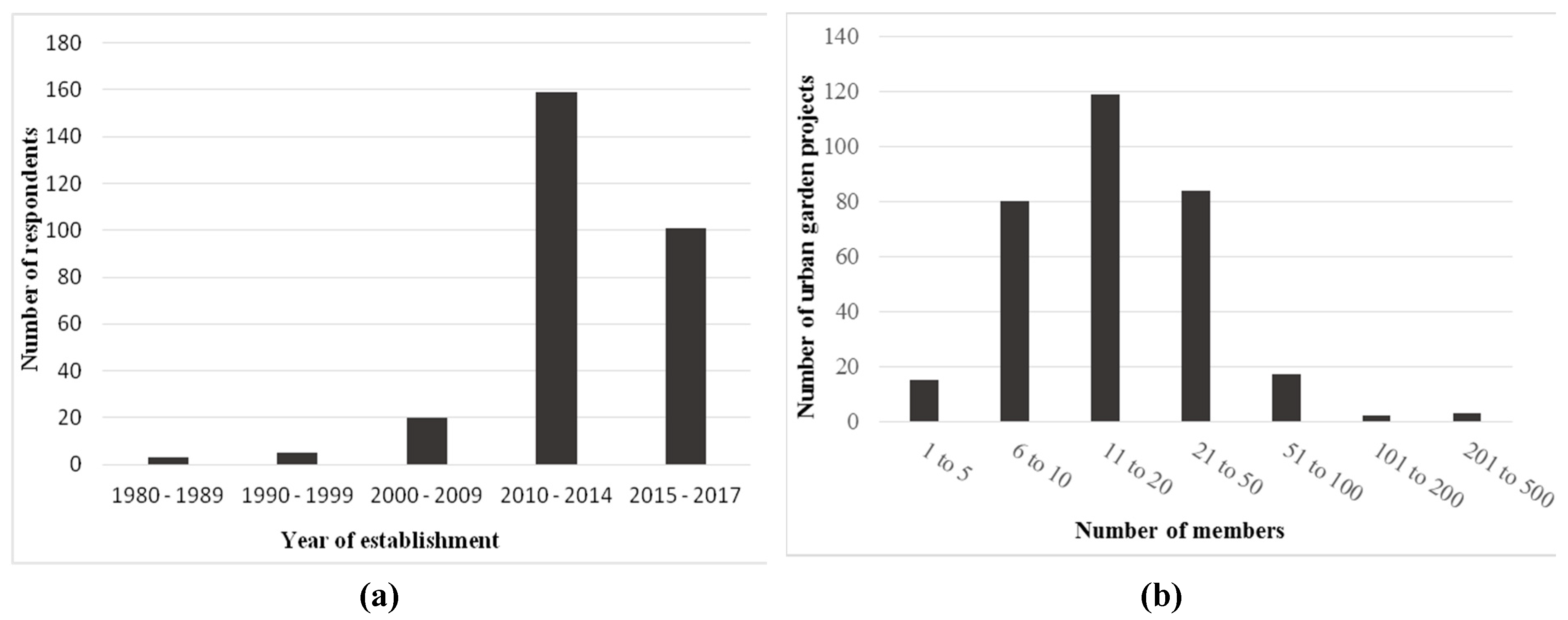
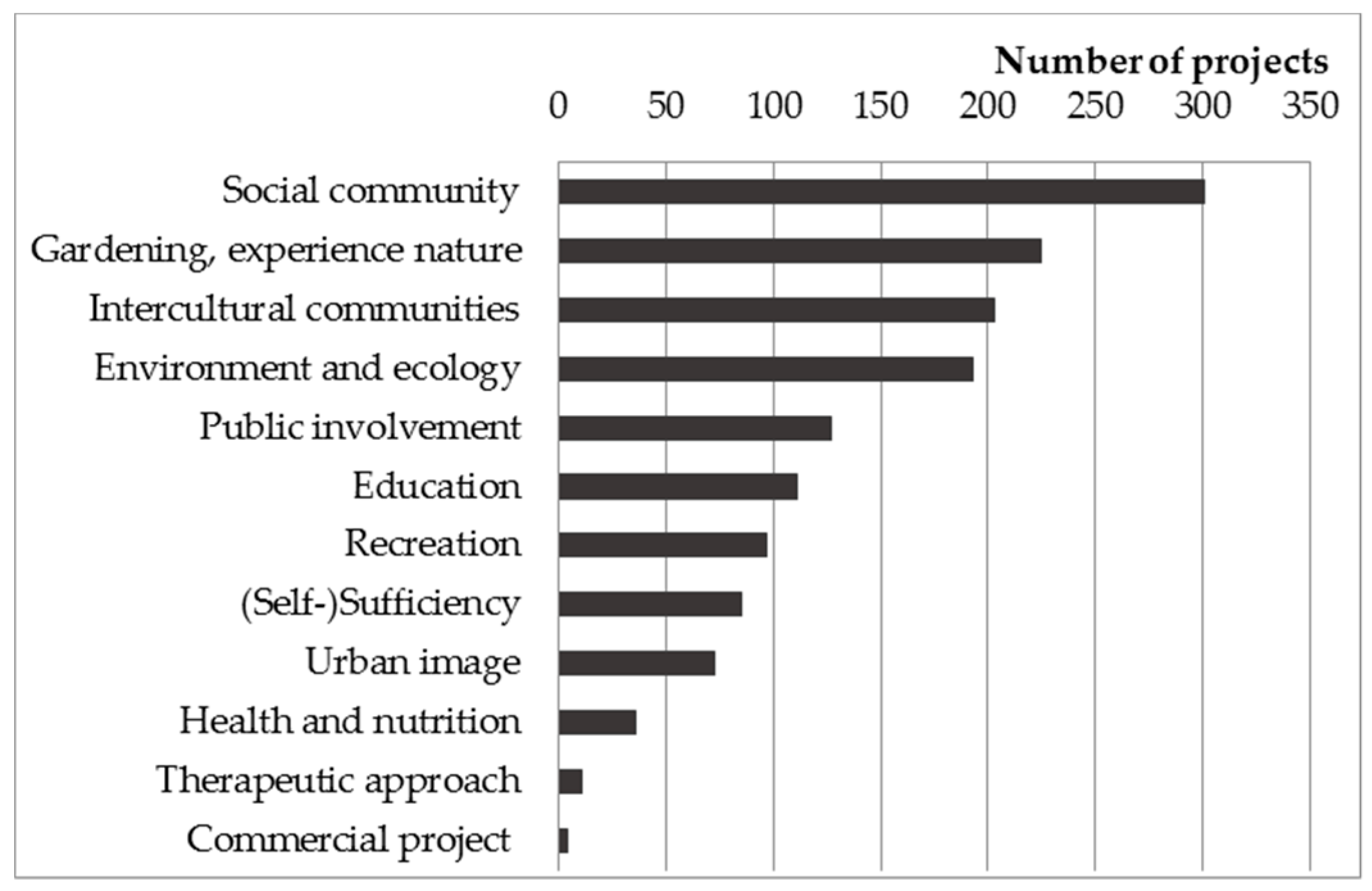
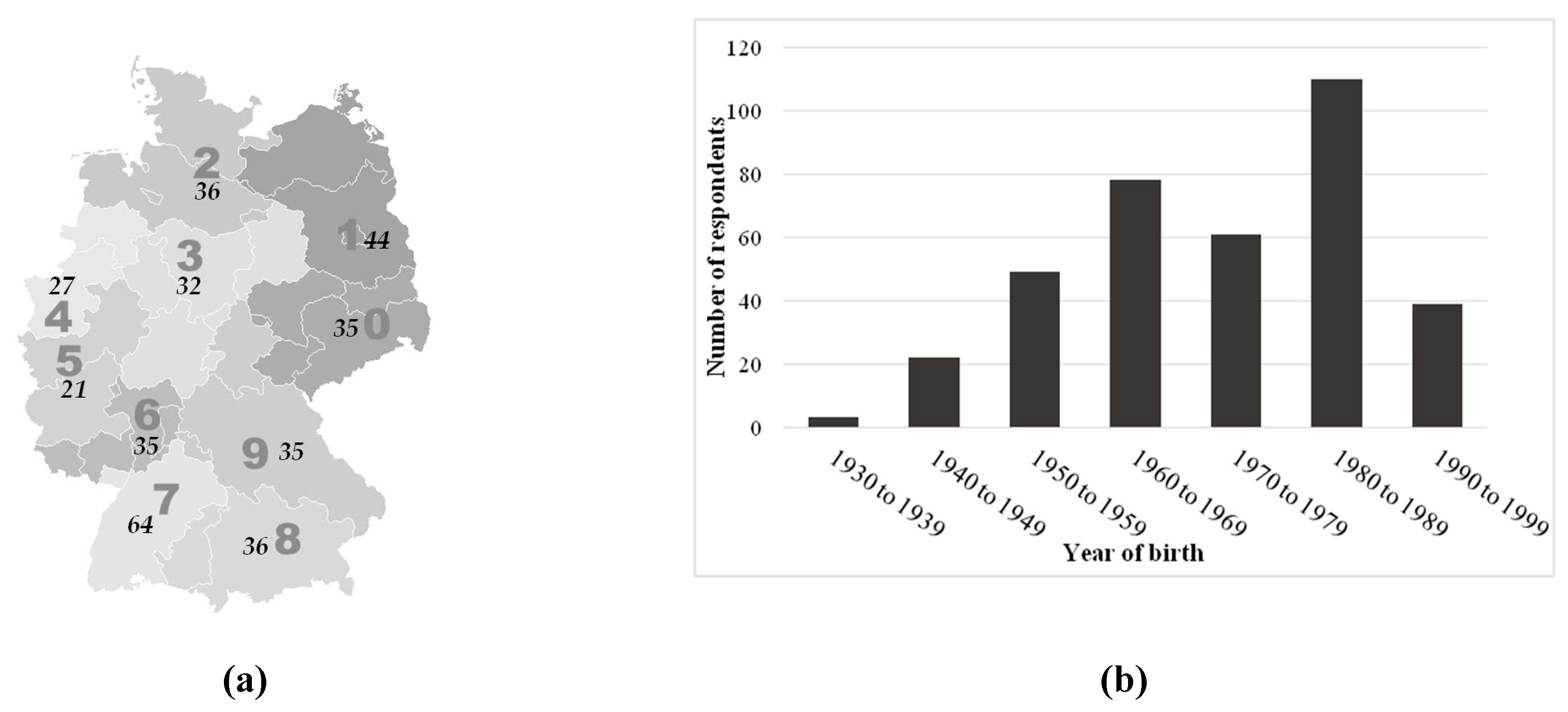
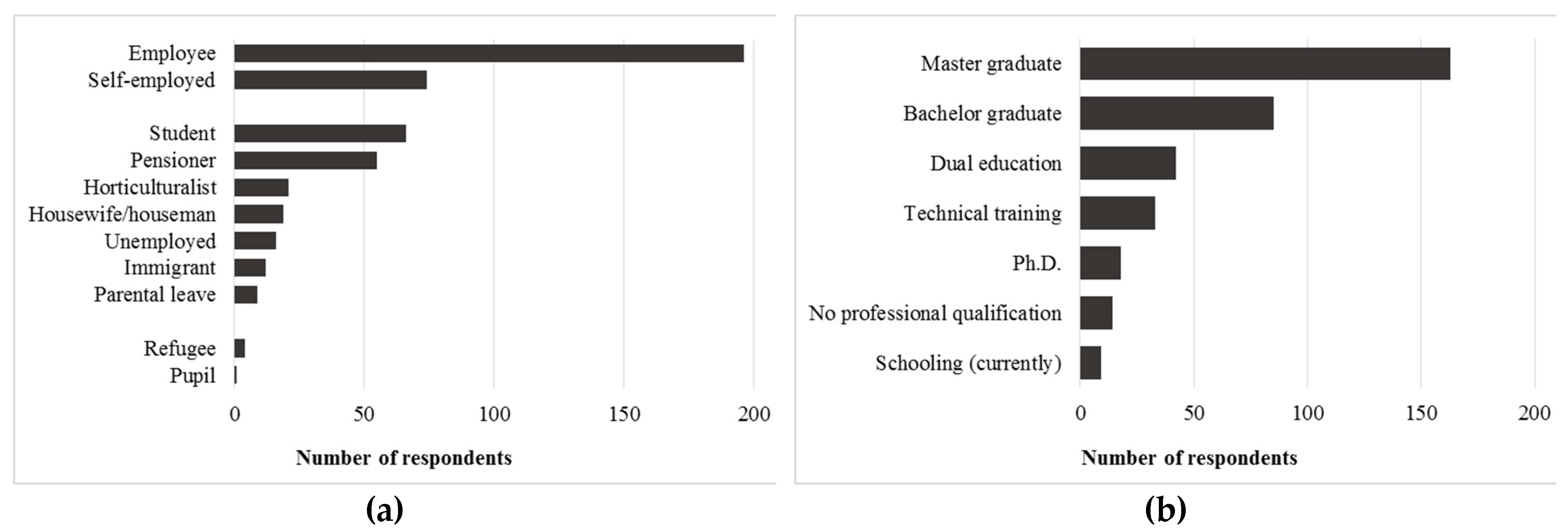
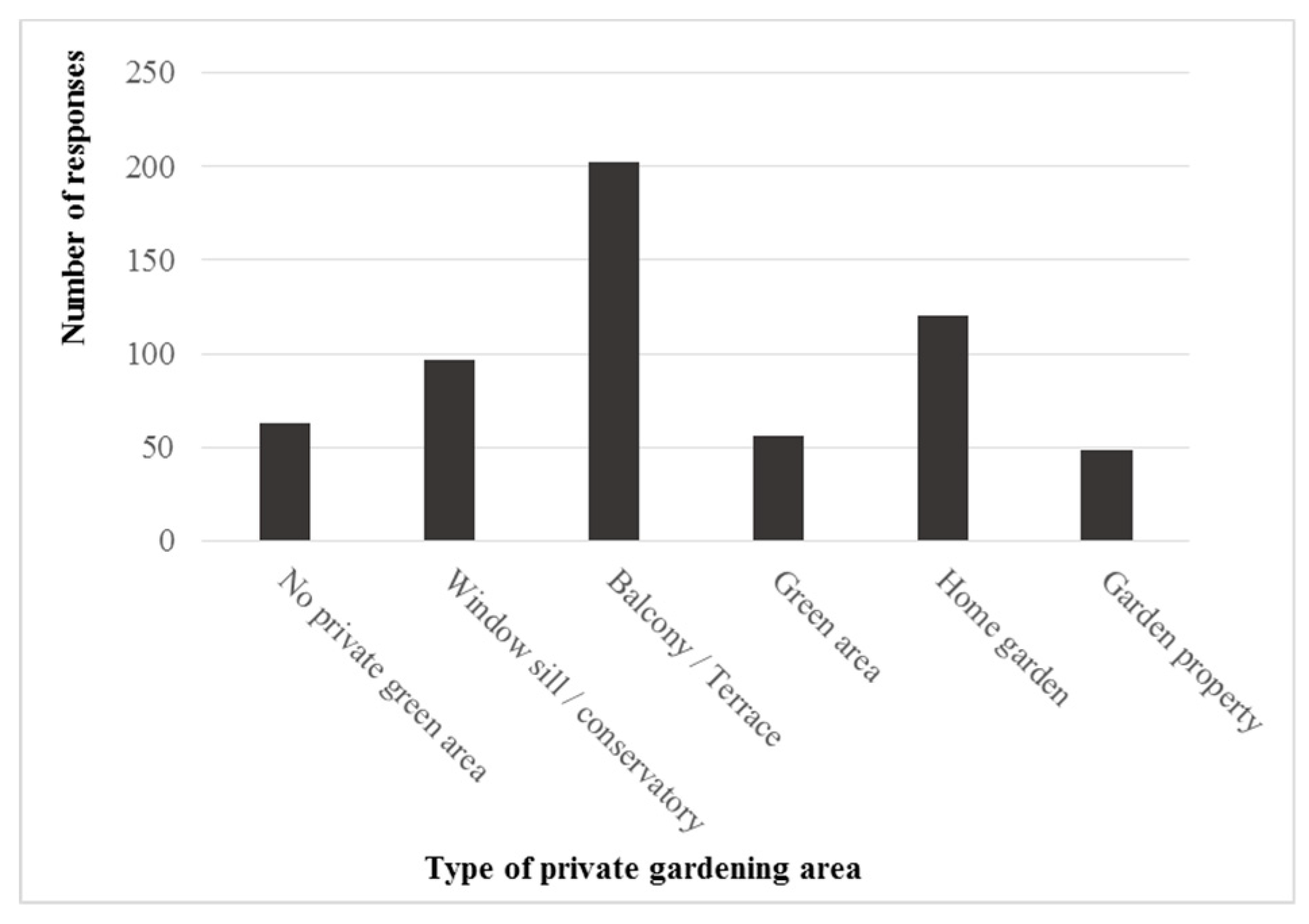
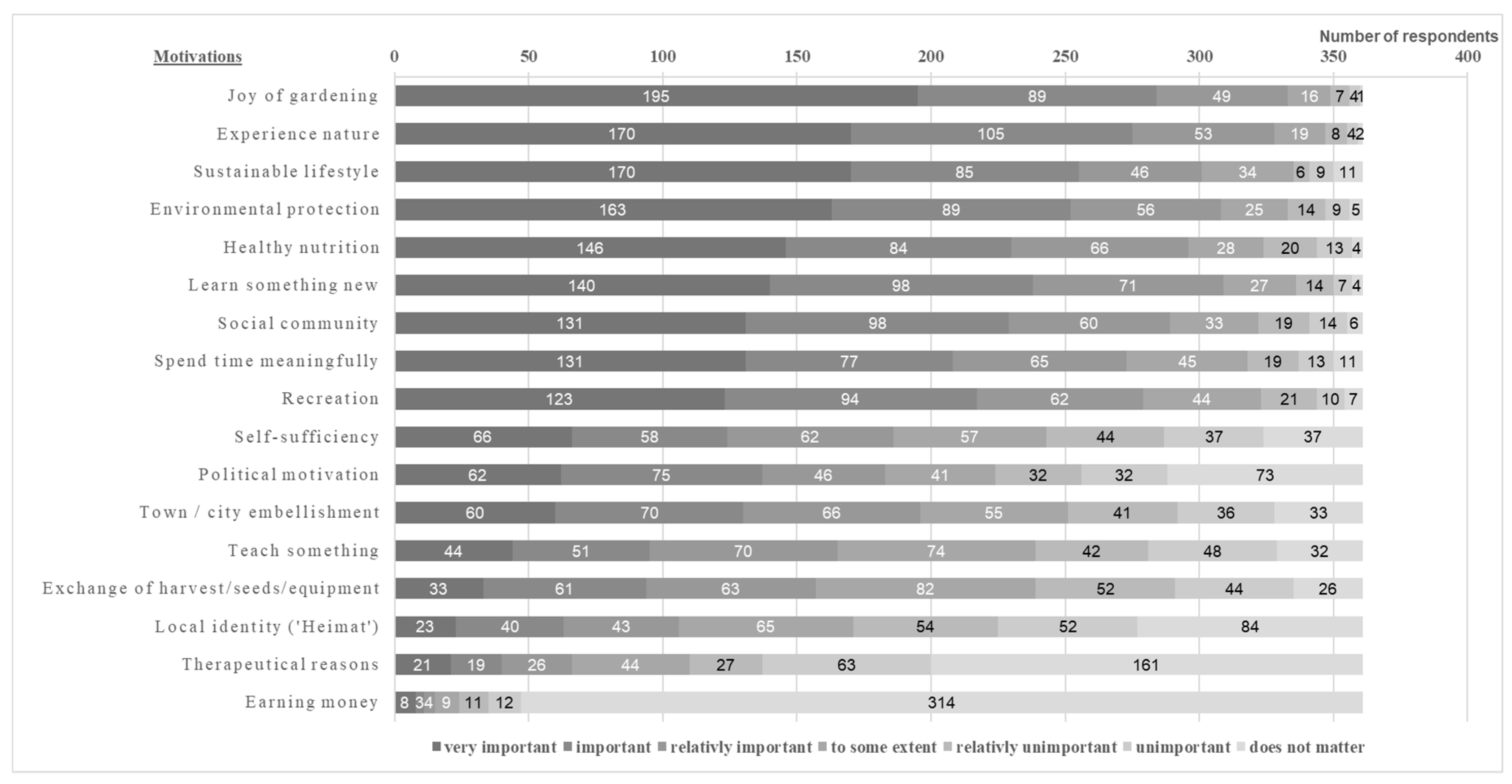
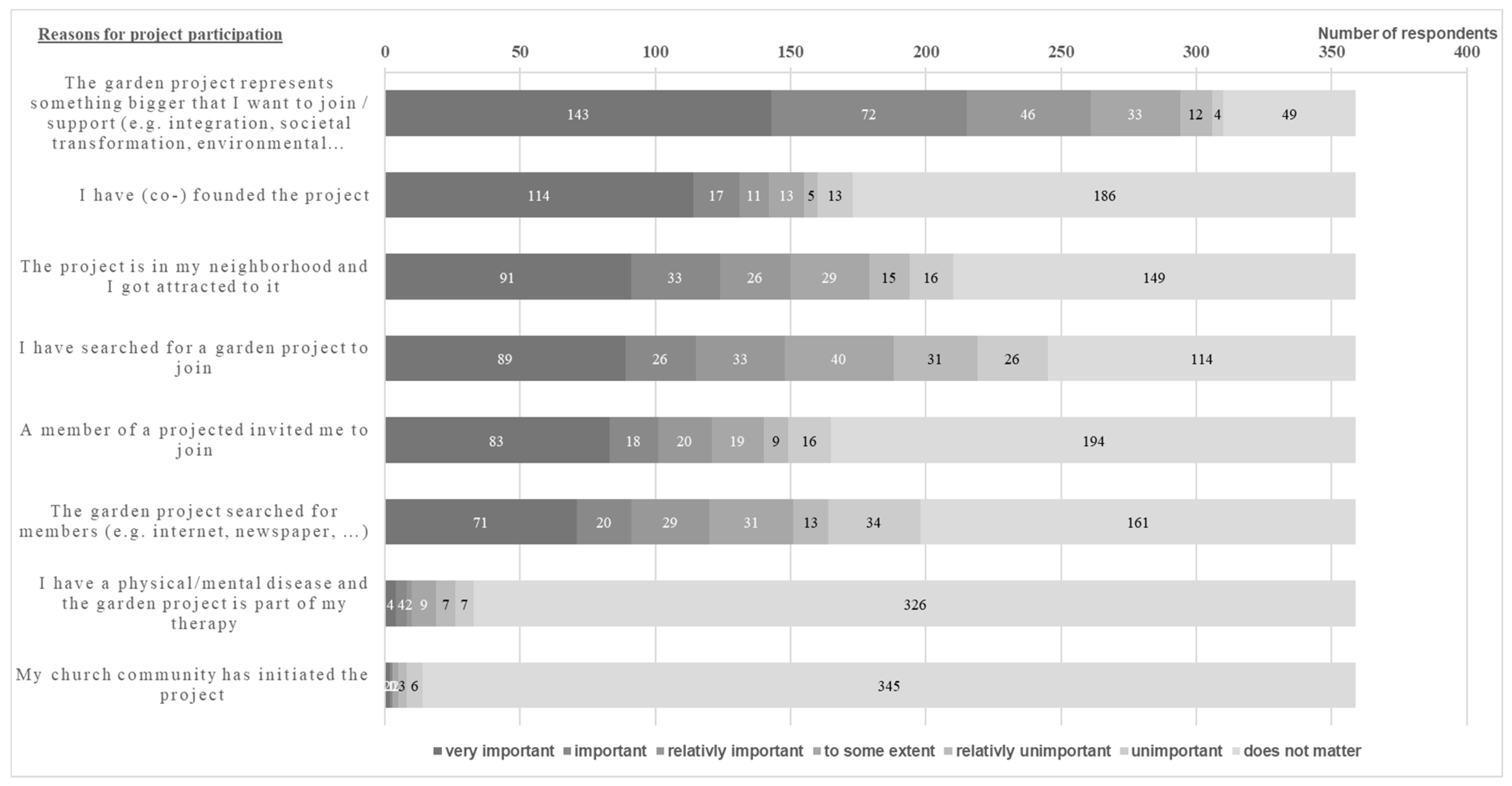
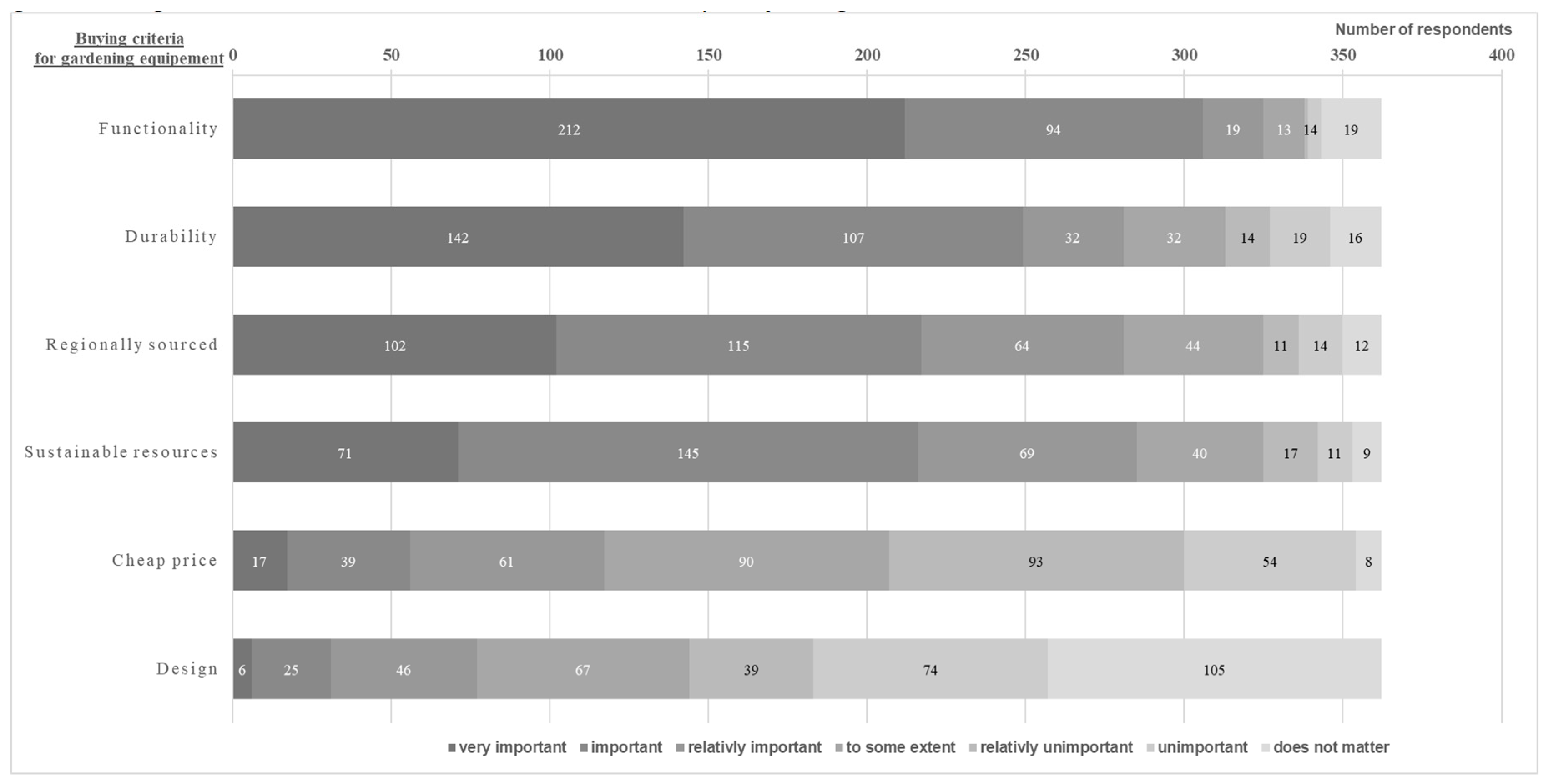
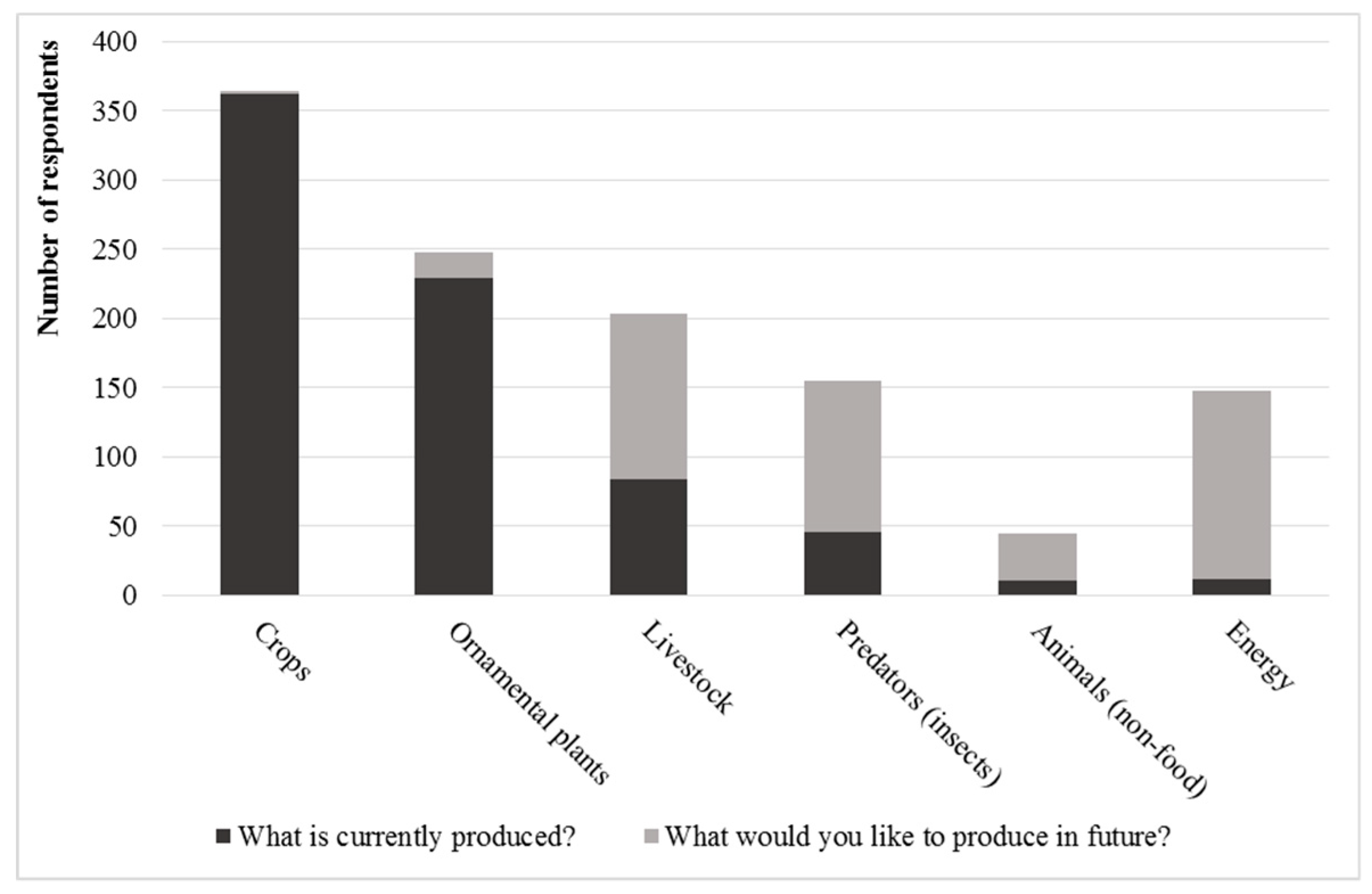
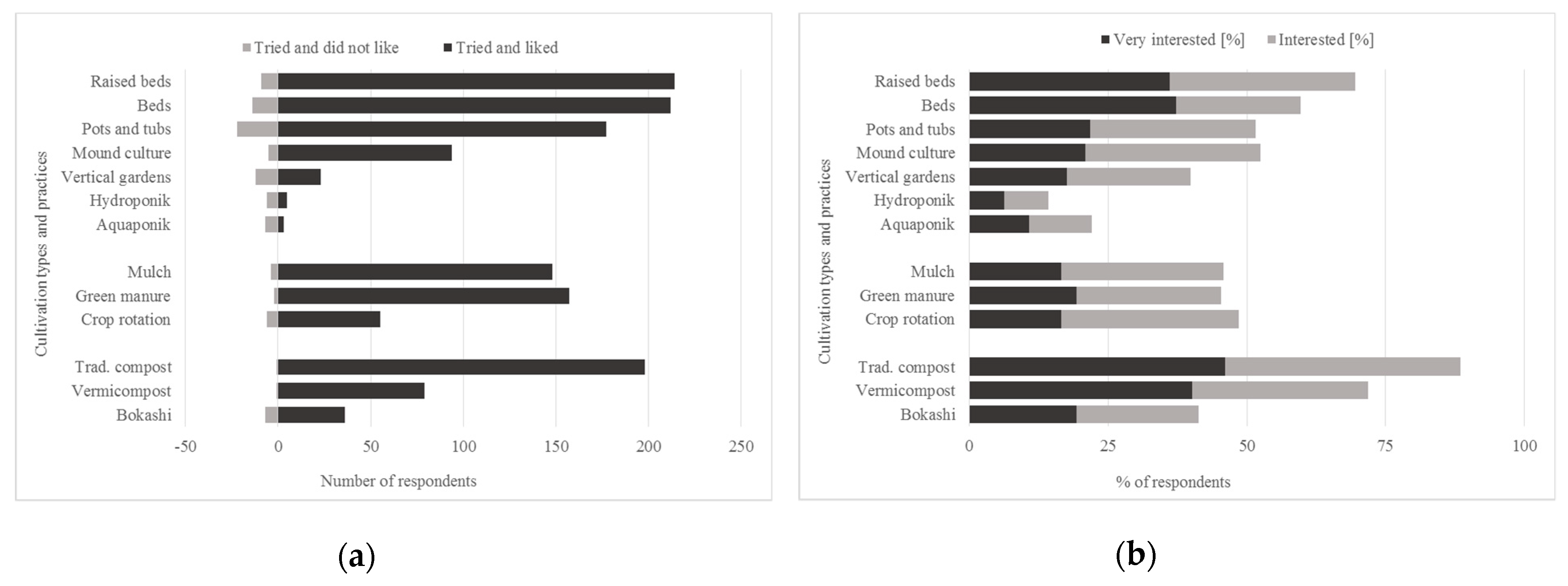
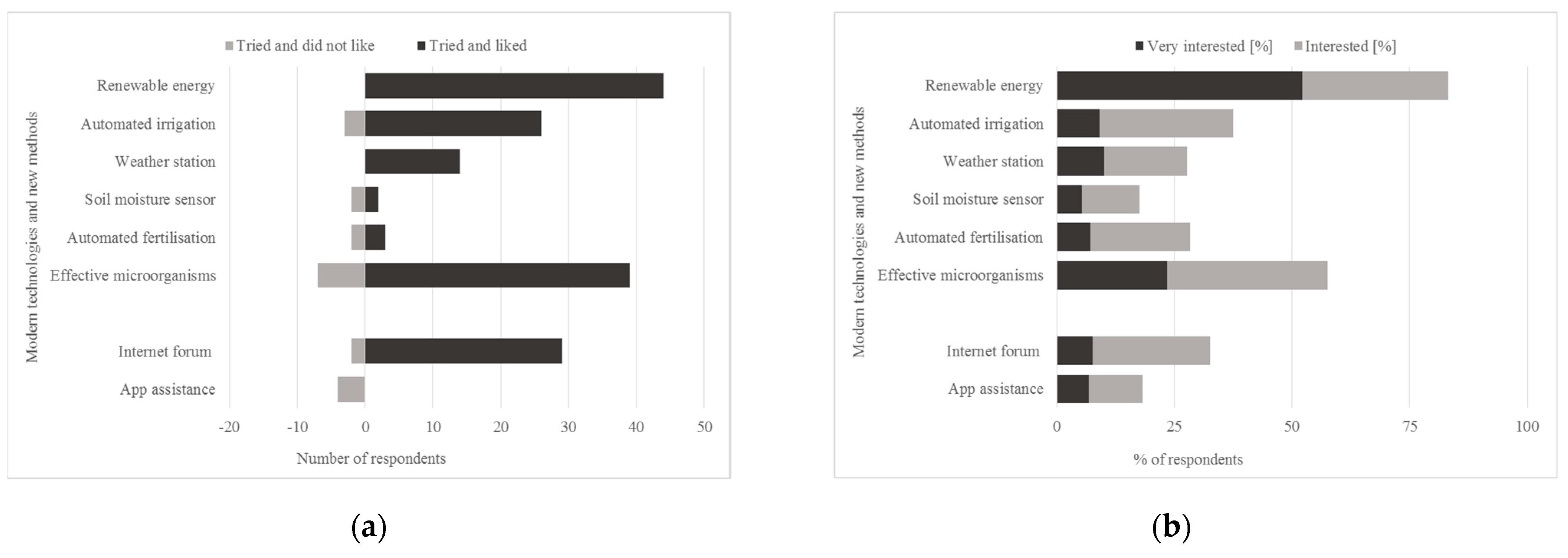
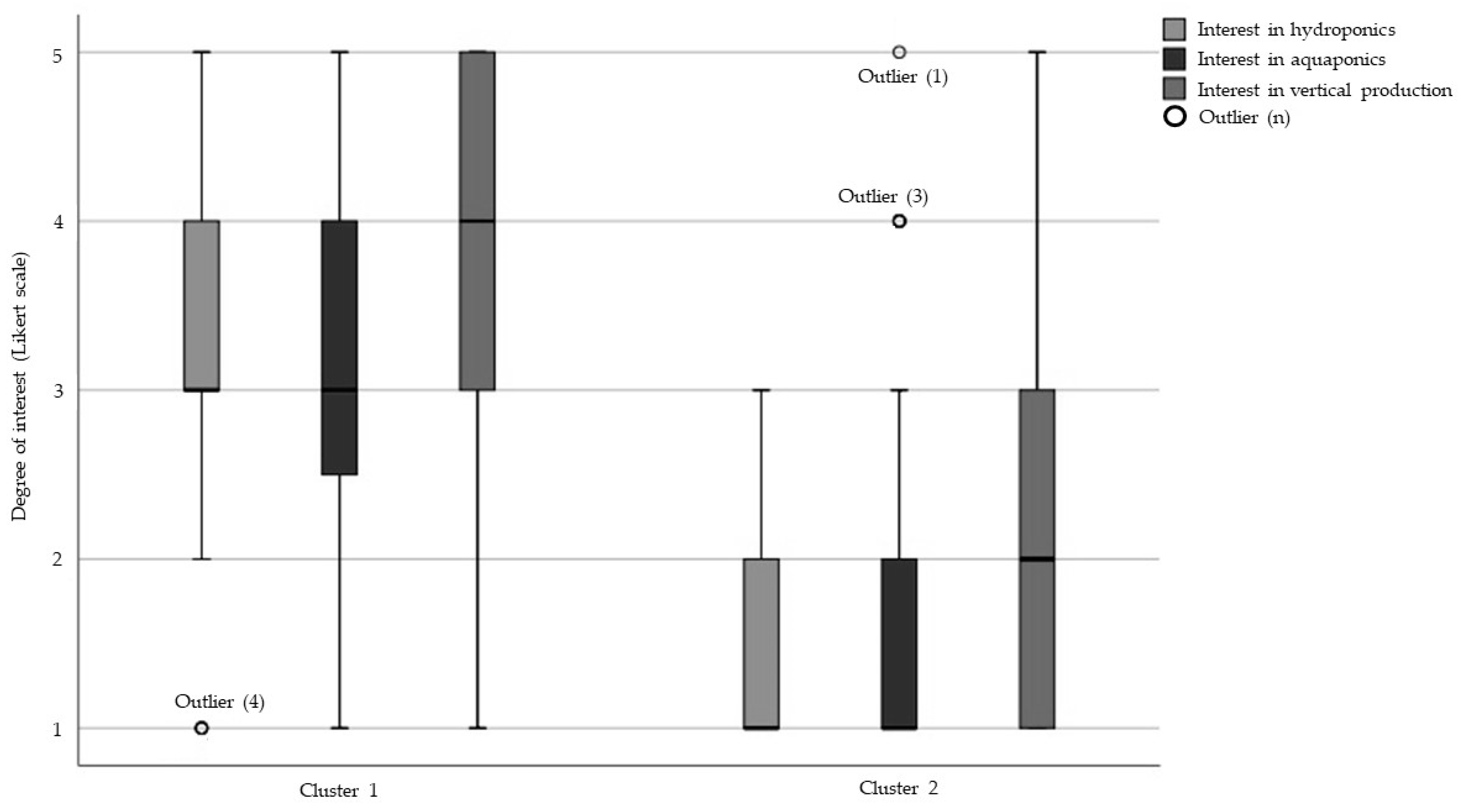
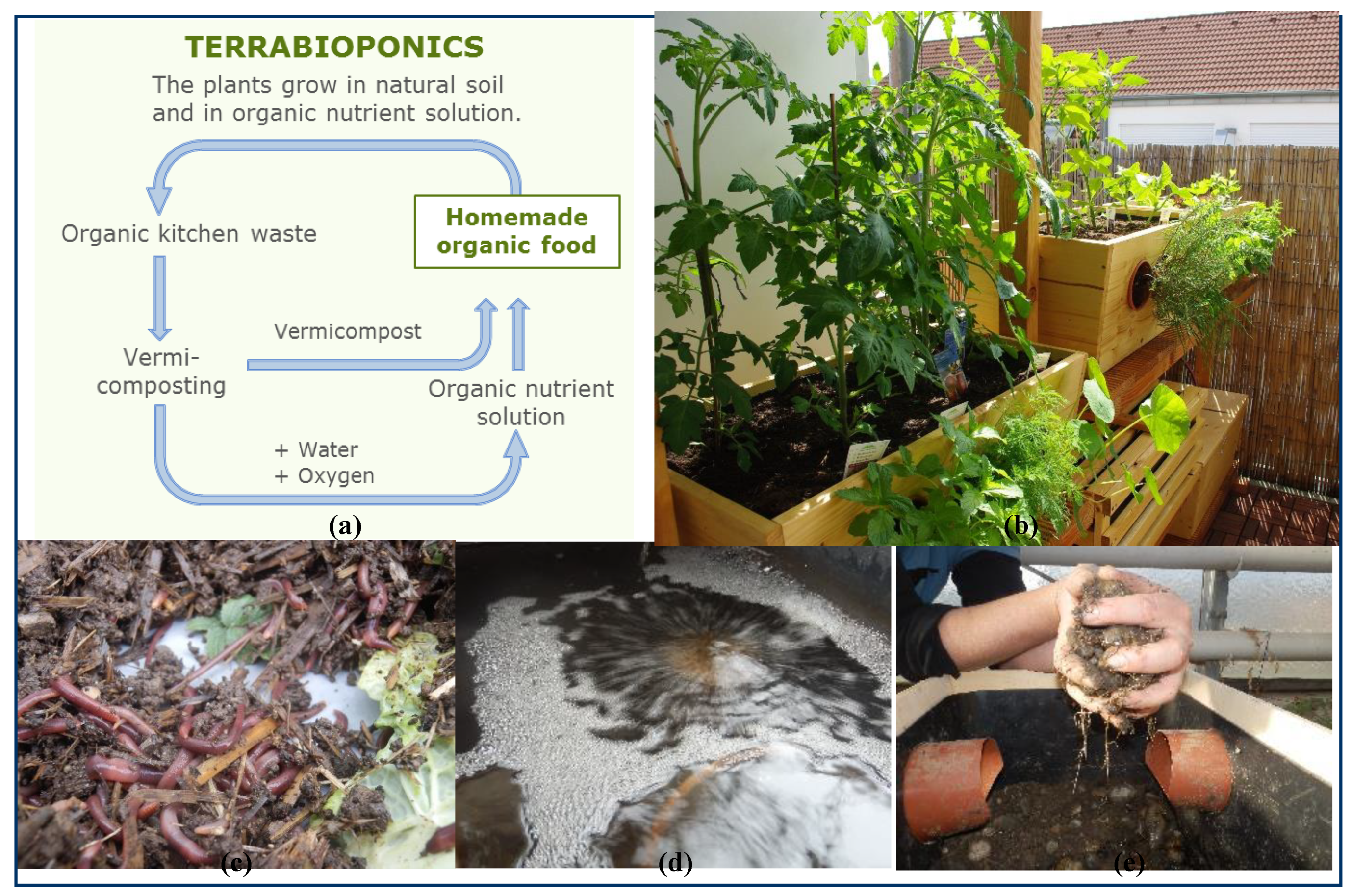
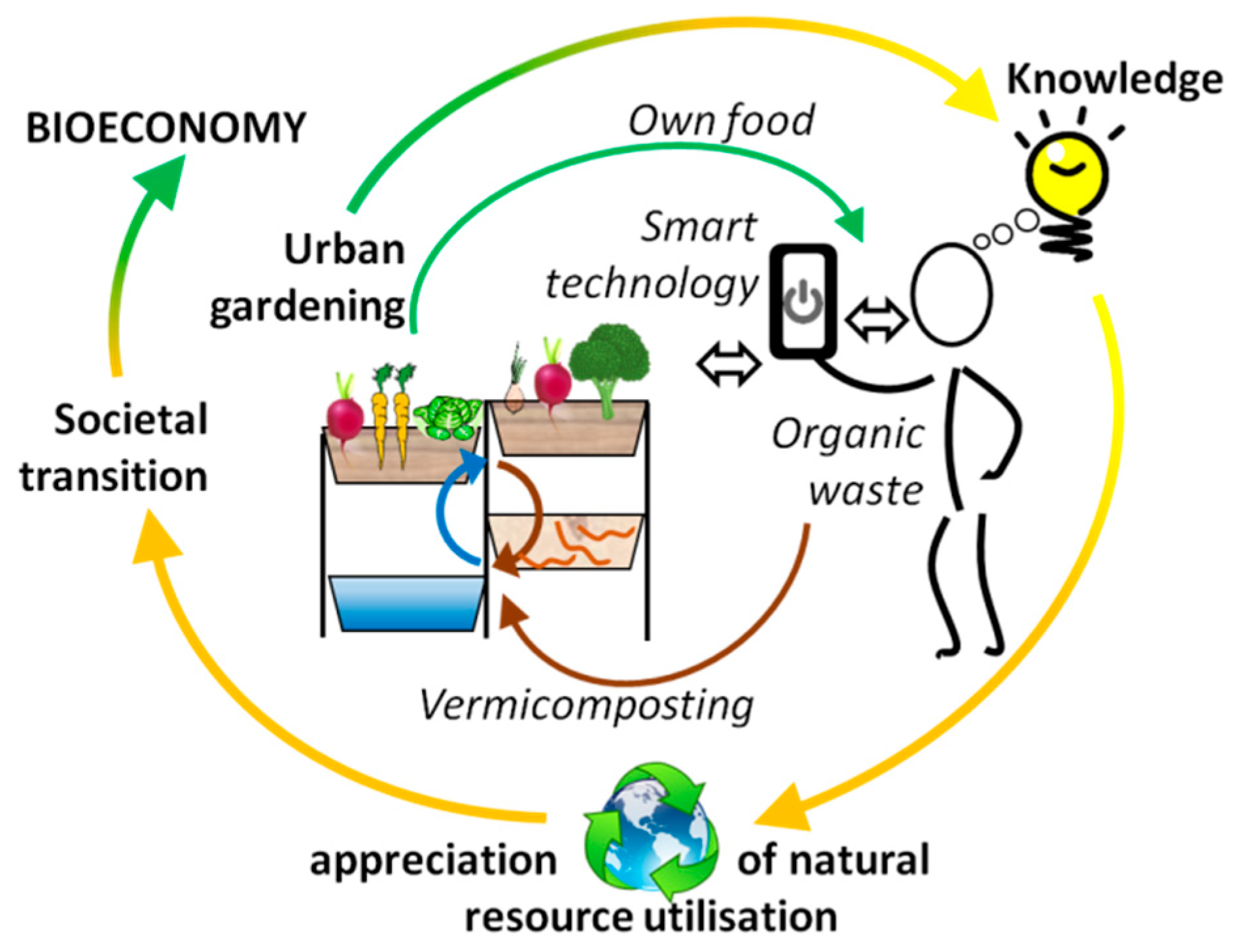
| Category | Sub-Category |
|---|---|
| Social community | |
| Social gathering and learning | |
| Social meeting, networking/exchange/community | |
| Neigbourhood vitalisation, solidarity | |
| Local identity (‘Heimat’) | |
| Gardening, experience nature | |
| Learn gardening, joy of gardening, fun | |
| Experience nature, work in/with nature | |
| Intercultural communities | |
| Cultural/social diversity | |
| Intercultural meeting, exchange and community | |
| Integration | |
| Environment and ecology | |
| Sustainability, sustainable lifestyle | |
| Future development | |
| Biodiversity | |
| Organic production, old varieties and diversity | |
| Soil fertility, permaculture | |
| Beekeeping | |
| Public involvement | |
| Public engagement/involvement/design | |
| Use of public spaces for communities | |
| Encourage (political) discussions | |
| Grassroots democracy, self-determination | |
| Education | |
| Education, environmental education | |
| Awareness of organic, regional and healthy nutrition | |
| Experimental garden, educational garden | |
| Recreation | |
| Relaxation, leisure time | |
| Cultural activities | |
| (Self-)Sufficiency | |
| Urban self-sufficiency, local food | |
| Urban image | |
| City greening/beautification, nature in the city | |
| Living space, local recreation areas | |
| Health and nutrition | |
| Healthy food, health, nutrition | |
| Organic food | |
| Therapeutic approach | |
| Trauma therapy, coping strategies | |
| Commercial project | |
| Urban gardening as a business model | |
| Production for sale (seeds, plants, foods, drinks) |
| Cluster 1 | Cluster 2 | Total | |
|---|---|---|---|
| Number of respondents | 119 | 184 | 303 |
| Interest in ‘new’ production methods [1 = not interested; 5 = very high interest] | |||
| vertical production | 3.93 | 2.38 | 2.99 |
| aquaponics | 3.31 | 1.51 | 2.21 |
| hydroponics | 3.27 | 1.38 | 2.12 |
| Gender [1 = male; 0 = female] | 0.41 | 0.28 | 0.33 |
| Gardening experience [in years] | 11.07 | 13.53 | 12.56 |
| Age [in years] | 43.13 | 46.70 | 45.30 |
| Residence during childhood [1 = town < 5.000 inhabitants; 4 = City > 100,000 inhabitants] | |||
| 2.50 | 2.43 | 2.46 | |
| Motivation for urban gardening [1 = not applicable; 7= fully applicable] | |||
| Earn money | 1.22 | 1.23 | 1.23 |
| Therapeutic aspects | 2.66 | 2.56 | 2.60 |
| Self-sufficiency | 4.61 | 4.20 | 4.36 |
| Political motivations | 4.24 | 4.20 | 4.21 |
| City/town beautification | 4.60 | 4.43 | 4.50 |
| Local identity | 3.58 | 3.26 | 3.39 |
| Learn something new | 6.03 | 5.67 | 5.82 |
| Healthy nutrition | 5.97 | 5.45 | 5.66 |
| Environmental protection | 5.93 | 5.78 | 5.84 |
| Sustainability | 5.95 | 5.73 | 5.82 |
| Exchange of harvest/seeds/tools | 4.51 | 3.95 | 4.17 |
| Solidarity within the gardening group | 5.76 | 5.55 | 5.63 |
| Recreation | 5.63 | 5.66 | 5.65 |
| Meaningful utilization of leisure time | 5.72 | 5.45 | 5.56 |
| Experience nature | 6.11 | 6.14 | 6.13 |
| Gardening pleasure | 6.29 | 6.18 | 6.22 |
| Dissemination of knowledge | 4.29 | 4.03 | 4.13 |
| Investigated Aspects of Consumer Behavior | Change [%] |
|---|---|
| Food self-sufficiency during summer | +471 |
| Food self-sufficiency during winter | +79 |
| Consumption of meat and sausage | −10 |
| Consumption of other animal products | −4 |
| Cooking with fresh ingredients | +18 |
| Consumption of traditional fruit and vegetable varities | +25 |
| Organically produced food | +26 |
| Regionally produced food | +35 |
| Seasonally produced food | +42 |
| Engagement in other projects supporting a sustainable future | +5 |
© 2019 by the authors. Licensee MDPI, Basel, Switzerland. This article is an open access article distributed under the terms and conditions of the Creative Commons Attribution (CC BY) license (http://creativecommons.org/licenses/by/4.0/).
Share and Cite
Winkler, B.; Maier, A.; Lewandowski, I. Urban Gardening in Germany: Cultivating a Sustainable Lifestyle for the Societal Transition to a Bioeconomy. Sustainability 2019, 11, 801. https://doi.org/10.3390/su11030801
Winkler B, Maier A, Lewandowski I. Urban Gardening in Germany: Cultivating a Sustainable Lifestyle for the Societal Transition to a Bioeconomy. Sustainability. 2019; 11(3):801. https://doi.org/10.3390/su11030801
Chicago/Turabian StyleWinkler, Bastian, Anika Maier, and Iris Lewandowski. 2019. "Urban Gardening in Germany: Cultivating a Sustainable Lifestyle for the Societal Transition to a Bioeconomy" Sustainability 11, no. 3: 801. https://doi.org/10.3390/su11030801
APA StyleWinkler, B., Maier, A., & Lewandowski, I. (2019). Urban Gardening in Germany: Cultivating a Sustainable Lifestyle for the Societal Transition to a Bioeconomy. Sustainability, 11(3), 801. https://doi.org/10.3390/su11030801







